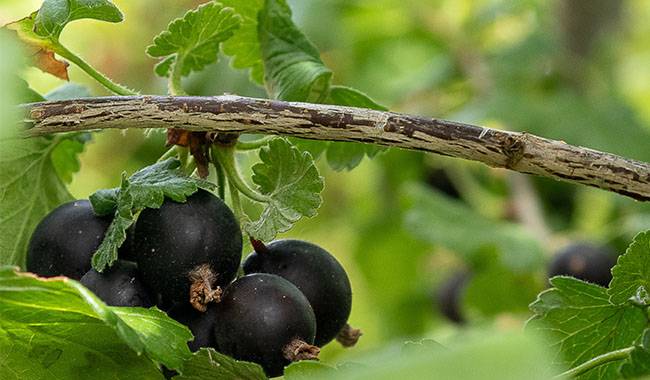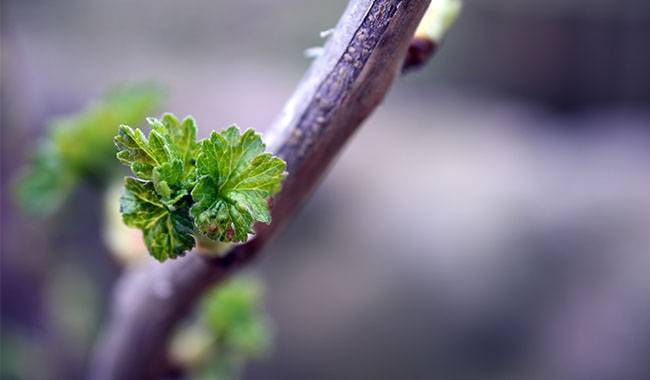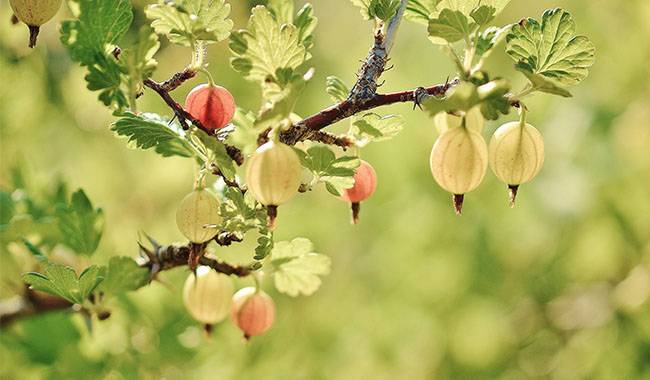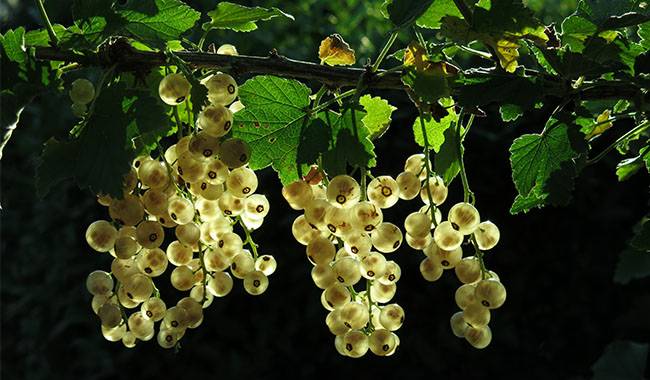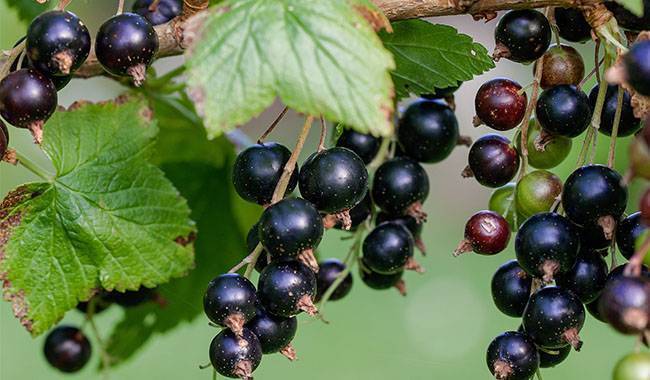
It’s springtime in the garden, berry, and vegetable gardens. Today we will discuss blackcurrant. What kind of care does this berry need during the spring? It must be said that the treatment of berries in spring is more important than in autumn.
If there is still snow and some work cannot be done, the order of work can be changed. For example, carry out spring cleaning of blackcurrant from debris accumulated during autumn and winter.
Do not carry out formative pruning and carry out blackcurrant bush care if it was carried out in the autumn. But let’s try to consider all the work in order
Spring care for blackcurrant includes these urgent tasks.
CLEANING BLACKCURRANT BUSHES
The main cleaning of old branches, fallen leaves, and weeds in blackcurrant bushes is done in the fall. However, during the fall and winter, debris builds up and must be removed. Carefully rake out the overwintered old leaves in the blackcurrant bushes and between the branches in the bushes, and be sure to burn them. Undoubtedly, in them, some overwintering pests are late to rest.
SANITARY PRUNING OF BLACKCURRANT
Check blackcurrant bushes thoroughly. Cut off all broken, inward-growing, diseased, and dry branches.
Check the lower branches and prune off those that are lying on the ground. They have been covered with snow. Trim them off at the last or penultimate live bud so that they are near the top. Pile up the branches.
Check for old blackcurrant branches whose effective fruiting has ended. These are branches that are 6-7 years old. They are covered with old, rough bark and have almost no young side shoots and buds. Such branches will not form a harvest, but they will take some nutrients from the younger ones. Cut them off near the ground and send them to the pile as well.
Transfer the live fruiting shoots to blackcurrant. Check them one by one from the bottom to the tips of the branches. If there are frozen parts, cut back a live shoot.
If the blackcurrant bushes look emaciated and the young fruiting shoots are thin, cut them all off to 3-4inch (8-10cm). This method saves the bush’s strength to form a harvest.
Recheck the fruiting shoots. On some branches, the shoots are swollen and round. There the mites have settled down for the winter. If the whole branch is infested with mites, cut it off without complaint. Otherwise, we may lose the harvest. Affected blackcurrant branches are bound to burn.
If there are 1-2 swollen buds on the fruiting branches of blackcurrant, pick them off and put them in a bag or pocket. Then burn them, as well as all cut branches.
REGULATION PRUNING OF BLACKCURRANT
After all preparatory pruning, proceed to annual pruning of blackcurrant bushes for bush loading.
Loading of blackcurrant bushes is carried out simultaneously with sanitary pruning. In young 2-3-year-old bushes, 3-4 well-developed shoots are left, and the rest are cut out in a ring at ground level. The stems are cut to form a temporary circle or quadrilateral roughly equidistant from each other.
Within this circle/square, no young growth should be left. The wider the base, the brighter the blackcurrant bush will be, and the larger the berry set will be.
Each year, the blackcurrant bush will be replenished with 3-4 annual shoots of the rootstock type. By the age of 5, the bush will have 8-12 strong fruiting branches. There can be more if the bush has a large diameter at the base. blackcurrant shoots are 3-5-6inch (8-13-15 cm) apart.
Second-order shoots are practically untouched. If the previous year’s growth equals or exceeds 15-18inch (40-45 cm), it can be shortened.
Remember! The width of the base of the blackcurrant bush depends on the correct planting method. Seedlings should be planted diagonally, not vertically. In the case of inclined planting, the bush will develop an additional root system and form more shoots from dormant buds.
The most active period of blackcurrant crop formation is 5-7 years, then the aging and fruiting of old branches decreases. These branches are first pruned in March when the bushes are loaded. 8-9-year-old bushes are uprooted and replaced by younger bushes that gradually transfer the berries to new locations.
The uprooting of blackcurrant can be replaced by rejuvenation, which is more practical in the spring before the buds open (March). All shoots are cut back in a circular fashion in rejuvenation, forming a bush from the new young shoots.
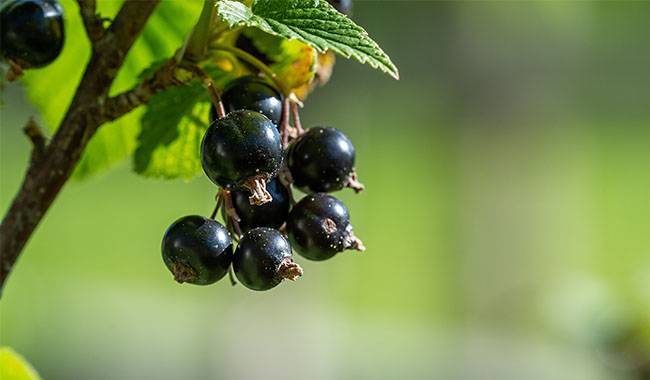
TREATMENT OF PESTS AND DISEASES
Immediately after pruning, pest and disease control of blackcurrant shrubs is started.
Experienced gardeners apply several types of treatments to dormant shrubs.
- Treatment by fire.
- Treatment with boiling water.
- Treatment with insecticide solutions.
- Treatment with biological agents.
Blackcurrant fire treatment
A large number of experienced gardeners have started to use early blackcurrant treatments (in early March, when the bushes are asleep) with blowtorch or airgun fire to control mites and aphids.
After pruning, the blackcurrant bushes are thinned sufficiently. The fire of the burner is pointed at the bush branches at a distance of 3-4inch (8-10cm) and led 2-3 times along the branches from top to bottom. As if stroking the fire.
Do not get close to the fire or hold the branches still. They do not need to be fried. Only scorch them on the surface. This kills aphid eggs and a large number of mites, which, from their numbers, overwinter in the swollen buds.
Remember! Only blackcurrant, red currant, white currant, and strawberry/grass berries can be treated with fire. Other types of berries (raspberries, blackcurrant, and others) should not be treated.
If there is still snow around, you can shovel it away from the blackcurrant roots and put it back in place a few days later.
If you are afraid of fire treatment, please go to one of the following, which, in your opinion, is not so dangerous.
Treating blackcurrant with boiling water
As with the fire treatment, do this in early spring when the blackcurrant bushes are dormant.
Use about 1-1.2 buckets of hot water for each large blackcurrant bush. Fill the sprinkler with boiling water and rinse with boiling water from a height of 6-8inch (15-20 cm) above the bush. By the time the water reaches the bush, the temperature will have dropped to 140-158°F (60-70°C) and will not damage the plants.
A bath will reduce the number of pests and fungal diseases, but it will not eliminate them completely. Therefore, at the stage of bud expansion, we will return to the issue of plant pest control.
Blackcurrant insecticide treatment
Treat blackcurrant bushes with a 1-2% solution of copper sulfate or a 3% solution of Bordeaux mixture from the end of March to the beginning of April. As recommended, a copper chloride solution can be used. Treatment with these preparations partially eliminates overwintering mites and aphids as well as fungal infections.
During the period, when blackcurrant buds begin to form, experts recommend treating bushes with dispersible sulfur or colloidal sulfur suspension. During this period, it is still possible to spray with “Use sulfur as an insecticide” and other approved preparations. Actara” and other preparations can be used.
However, the use of chemical preparations is undesirable in private gardens, and in homes with small children, the use of chemical preparations is prohibited. Ecological cleaning products can be obtained by using biological preparations, infusions, and decoctions of insecticidal plants.
Treatment of blackcurrant with biological agents
Biological preparations can be used to treat currants in all warm seasons until harvest, which will help to get rid of mites, aphids, fireflies, fungal infections of different diseases, and other pests and diseases.
The maximum effect of the biological preparation is shown at a positive temperature of 59-64°F (15-18°C).
CAUTION! It is necessary to dilute and use biological preparations exactly as recommended. Then their effect will be maximum.
Biological preparations are harmless to humans, animals, and birds. They start working after a few hours. Their effect lasts at least 2-3 weeks. Repeated treatments before the end of the drug effect are carried out only after the rains.
For the protection of plants from pests, use “BITOXIBACILLIN” and others.
For disease protection – “Trichodermin,” “Alirin – B” and others.
Biological preparations are well mixed in the tank mixture, which reduces the number of treatments and the load on the shrubs during treatment.
Decoction and infusion of insecticidal plants
Now appear tips and recommendations for gardeners and horticulturists on the use of insecticidal plants to protect fruit crops from pests.
- Infusion of garlic.
- Infusions of bilberry, marigold (tagetes), dandelion, yarrow.
- Fresh potato leaves.
- Aqueous decoction of tobacco, yarrow, etc.
In addition to harmless insecticidal plants, suggestions abound for the use of very poisonous plants that kill a poor percentage of pests and act as a poison when used on unwashed berries in food. Please note!
FERTILIZATION OF BLACKCURRANT
Fertilizer application rules for each type of fertilizer.
- Apply fertilizer with a diameter equal to or slightly larger than the canopy of the bush.
- Apply fertilizer evenly on all sides, spreading it on the soil surface during watering or shallowly burying it 2-3inch (5-8cm) into the soil.
- In early spring, blackcurrant bushes can be fertilized with a deep application of organic matter or whole manure. Depending on the age and size of the bush, dig a trench 12inch (30 cm) deep and 3-4inch (8-10 cm) wide along the perimeter at a distance of 20-24inch (50-60 cm). Pour a solution of organic or mineral fertilizer into it, absorb it and cover it with soil.
- The fertilizer solution can be applied directly to the surface of the loose soil under the blackcurrant shrub. In this case, after fertilization, the soil is watered with clean water and covered with mulch.
Stages of blackcurrant fertilization
During the spring, 2 fertilizations were made.
- at the stage of starting flowering. Late maturing varieties form shoots of 0.4-0.8inch (1-2 cm) in the same year.
- The beginning of the mass setting of berries.
First spring fertilization of blackcurrant
Fertilization of blackcurrant starts at the age of 3 years (first fruits).
If fertilization has not been applied under blackcurrant since autumn, the first spring fertilization is carried out.
- solution of organic fertilizers (manure, poultry manure).
- Total mineral fertilizer.
- A mixture of organic and mineral fertilizers.
To fertilize blackcurrant’s manure, use a solution of 1 part of cow manure to a concentration of 10 parts of water and add 20-25 grams of urea or ammonium nitrate.
If you use poultry manure instead of manure, dissolve 1 part of manure in 3-4 Gal (12-15 liters) of water and add urea.
In the absence of organic matter, you can make nitroglycerin at a rate of 30-40 g per bush, then water and mulch.
If blackcurrant bushes are large and highly knotted, it is better to make an organic mineral mixture in spring with manure or poultry manure and phosphorus and potassium fertilizer. Dilute 1 part of manure with 2.5 Gal (10 liters) of water, add 20-25 g of calcium superphosphate and 10-15 g of potassium sulfate.
Mix the mixture well and apply it to the furrows located at the edges of the current trees. After applying and closing the manure, you can water the bush with a moderate amount of water (do not dilute the manure).
If in autumn the soil under blackcurrant is filled with phosphorus and potassium fertilizers, then in the first spring application, use only nitrogen in the form of urea or ammonium nitrate at a rate of 50-60 g/11 sq. ft. area. 1/2 of the prescribed rate is available for bushes older than 4 years.
Second spring fertilization of blackcurrant
Depending on the time period, the second spring fertilization of blackcurrant is after 14 days or at the stage of heavy berry set. Currants in this period need micronutrients in addition to basic fertilizers. Plants can get them in the form of top dressings.
- on 0,5-1,0 cup of wood ash under the bush, followed by a shallow burial by loosening and watering, and mulching.
- 2-6,5 Lb (1-3 kg) of humus mixed with potassium sulfate can be applied under each bush. The treatment after fertilization is the same as for the application of ashes.
- Mineral fertilizers containing trace elements – “Kemira” and others – can be used for topdressing. They can be applied to the soil under bushes or foliar feeding by spraying the solution. Soil applications are 50-60 grams per 11 square feet of area. For foliar applications, dissolve 10 g of fertilizer per 2-2.5 Gal (8-10 L) of water and spray.
- Foliar feeding can be done within 7-8 days after the first root feeding, using boric acid, wood ash infusion, “Kemira” and other micronutrient kits, which are sold in specialized stores.
The second foliar spraying of blackcurrant is done in early summer when the berries are growing. The dosage and feeding method are the same.
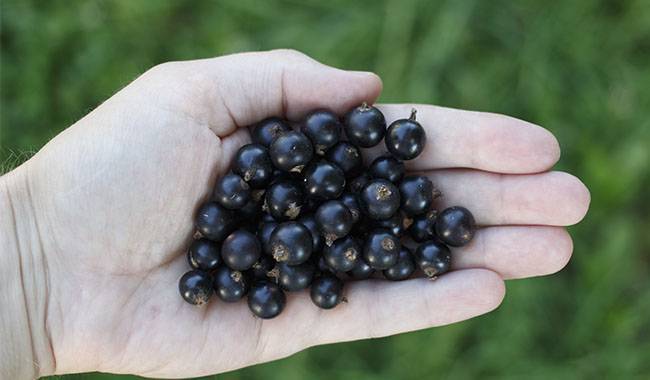
WATERING BLACKCURRANT
In early spring, currants are usually not watered separately. Watering is used for fertilization.
The first independent watering of the blackcurrant takes place during prolonged dry weather during the mass flowering stage. The first watering of the blackcurrant takes place at the stage of ovary formation (around the end of May) in case of sufficient winter water reserves.
The second watering of the blackcurrant is already in summer. It is carried out at the stage of growth (ripening) of berries.
Currants like to be irrigated with sprinkling water. They are best done before or after flowering. During the flowering period or if there are no sprinklers, watering can be done with a hose.
- In a furrow between rows.
- Under the bushes, there is a roller for holding water.
- Into the ditch made around the bush and in other ways.
It is important to water the blackcurrant when the soil is well soaked in a 15-24inch (40-60cm) layer of soil.
Loosening the soil and spreading the mulch
To retain water longer after absorption, loosen and mulch the soil under the blackcurrant bushes. You can use mulch under the bushes.
- Mature compost.
- Humus.
- Neutral peat.
- Decayed sawdust or shavings, mowed lawn grass, or mowed cobwebs.
The application of mulch retains moisture and acts as an additional organic fertilizer, and helps improve the physical properties of the soil.
Berry beds should be kept clean. The timely elimination of weeds and loosening of the soil will increase the access of air to the plant roots and improve the microclimate of the root-bearing layer. Completion of the spring project will lay the foundation for the formation of high-yielding blackcurrant and high-quality berries.
Dear readers
The specifications and combinations of blackcurrant root and foliar fertilization, as well as chemical and biological agents for pest and disease control, presented in the article, are not dogma. There is no doubt that many gardeners and horticulturists have used their time-tested berry management methods for many years. Please share your experiences with us in the comments.
More related information about growing currant plants




